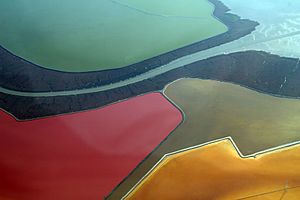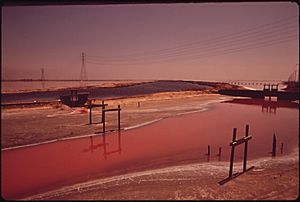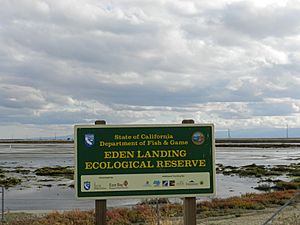San Francisco Bay Salt Ponds facts for kids

The San Francisco Bay Salt Ponds are a special part of San Francisco Bay. They cover about 16,500 acres. For a long time, people have used these areas to make salt. This started way back during the California Gold Rush. Most of these ponds used to be natural wetlands. They were found near cities like Redwood City, Newark, and Hayward.
People have been making salt here for a very long time. The Ohlone people, who lived here first, made salt from the bay. After the 1850s, more people arrived. This led to bigger salt-making businesses. At first, many small family businesses made salt. Later, larger companies took over. These included the Oliver Salt Company and Leslie Salt. Eventually, a company called Cargill bought out most of these businesses. They became the main salt producer. Since 2003, there's been a big effort. The goal is to close many ponds and turn them back into natural wetlands. This huge project might take up to 30 years to finish.
Colorful Ponds and Bay Animals
The San Francisco Bay is a unique place on the West Coast of the United States. It has the perfect weather for making salt from seawater. Lots of sun and wind help the water evaporate. This makes it a good spot for salt businesses.
These salt ponds are famous for their bright colors. They can be anything from bright pink to blue-green. You can see these colors best if you look down from an airplane. The amazing colors come from tiny living things. These include brine shrimp and very small organisms. They all live in the water, which has different levels of saltiness. Some specific tiny organisms, like synechococcus, halobacteria, and dunaliella, give the ponds their special colors.
Salt Making Through Time
The Ohlone people were the first to make salt from the bay. They let bay water dry up in natural tide pools. During the Gold Rush, salt was very important. People used it to keep food fresh. Many industries also needed salt. Because of the good conditions and high demand, salt production grew very quickly.
At that time, many people thought marshlands were not useful. They wanted to use the land for other things. This led to about 80% of the original marshes being changed. Over time, many smaller salt makers sold their land. They sold their rights to make salt to bigger companies. The Oliver Salt Company grew, and later the Leslie Salt Company became very big. In 1978, Cargill bought Leslie Salt. This made Cargill the main owner of land and salt rights in the area.
In 2003, Cargill sold most of its salt ponds. They sold them to groups like the California Coastal Conservancy and the United States Fish and Wildlife Service. Private groups also helped buy the land. The main goal was to turn these ponds back into natural wetlands. This big project is called the "South Bay Salt Pond Restoration Project."
Not all the salt ponds are being restored. Cargill has suggested building homes on some ponds in Redwood City. However, some people have raised concerns about this plan.
South Bay Salt Pond Restoration Project
This project is a huge effort by California and the U.S. government. They are working to restore about 15,100 acres of former Cargill salt ponds. These ponds are located in San Francisco Bay. In 2000, Cargill suggested selling much of its land. They wanted to sell 61% of their South Bay operations.
Senator Dianne Feinstein helped lead the talks. In 2002, a plan was agreed upon. Many groups signed it, including the California Coastal Conservancy and Cargill. California approved buying the land in 2003. Today, the land is owned and managed by the U.S. Fish and Wildlife Service and the Department of Fish and Game. The project's goal is to turn 90% of the old salt ponds back into natural wetlands. The Native Plant Nursery helps by providing plants for the project.
This project is the largest wetlands restoration on the West Coast. It covers over 15,000 acres and will last 50 years. It helps in many ways. It controls floods and reduces pollution. It also creates more homes for wildlife. Plus, it gives people places to visit and enjoy nature.
The South Bay Salt Pond Restoration Project combines restoration with flood control. It also creates chances for people to visit and learn about wildlife. The restored tidal marshes will be important homes. They will help endangered animals like the California clapper rail and the salt marsh harvest mouse. Large marsh areas will also have many channels. These channels will provide homes for water animals and harbor seals. Flood control will also protect nearby communities. The project offers many fun things to do. These include trails for hiking and biking, hunting, and bird watching. People can also learn about the environment.
Eden Landing Ecological Reserve is one area being restored. The Hewlett Foundation has given money to help restore the Bay Area Salt Ponds.




